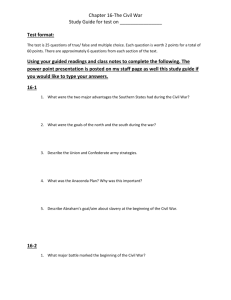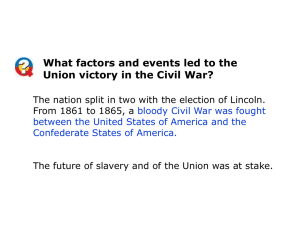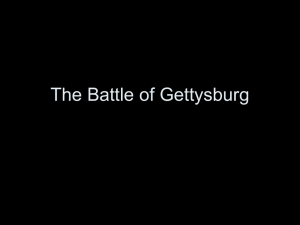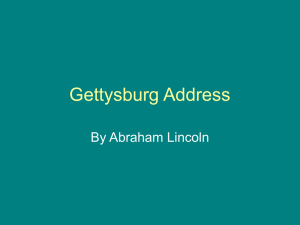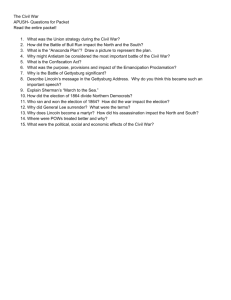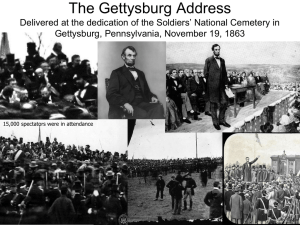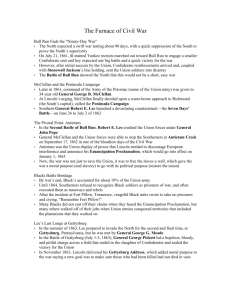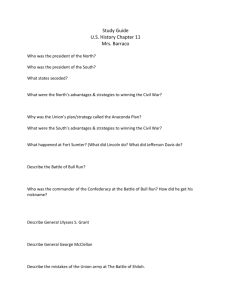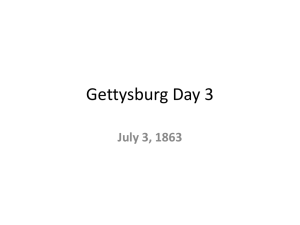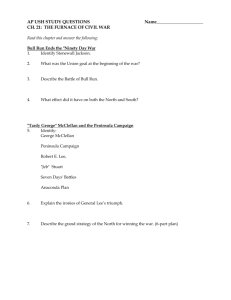1860s Military Technology - Waterford Public Schools
advertisement
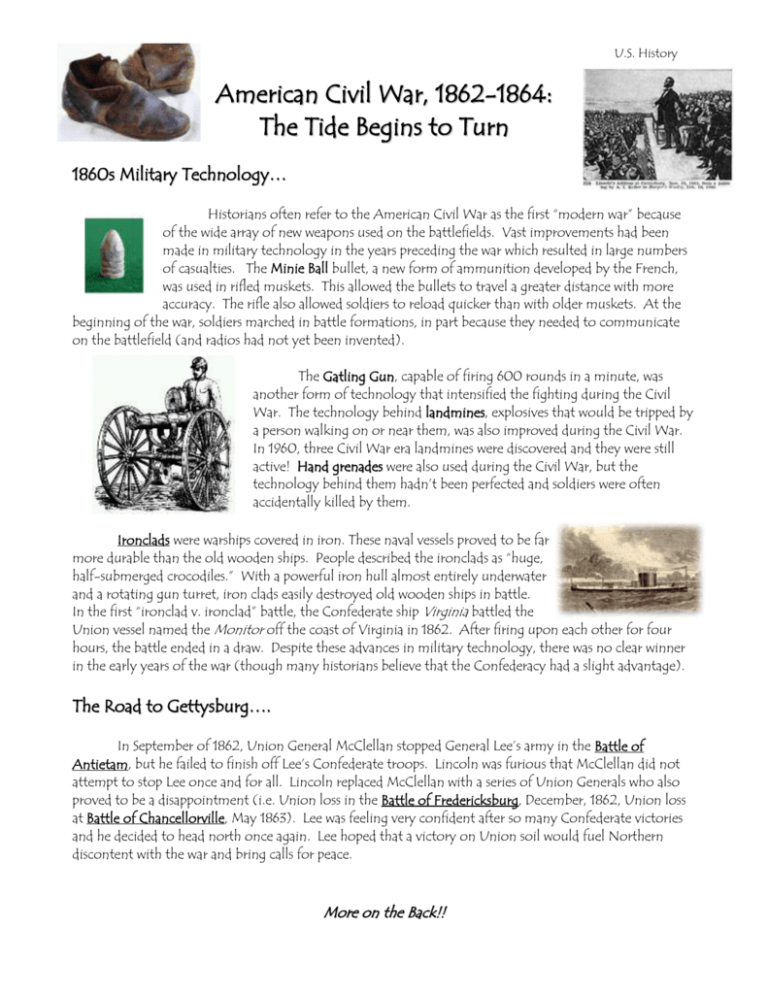
U.S. History American Civil War, 1862-1864: The Tide Begins to Turn 1860s Military Technology… Historians often refer to the American Civil War as the first “modern war” because of the wide array of new weapons used on the battlefields. Vast improvements had been made in military technology in the years preceding the war which resulted in large numbers of casualties. The Minie Ball bullet, a new form of ammunition developed by the French, was used in rifled muskets. This allowed the bullets to travel a greater distance with more accuracy. The rifle also allowed soldiers to reload quicker than with older muskets. At the beginning of the war, soldiers marched in battle formations, in part because they needed to communicate on the battlefield (and radios had not yet been invented). The Gatling Gun, capable of firing 600 rounds in a minute, was another form of technology that intensified the fighting during the Civil War. The technology behind landmines, explosives that would be tripped by a person walking on or near them, was also improved during the Civil War. In 1960, three Civil War era landmines were discovered and they were still active! Hand grenades were also used during the Civil War, but the technology behind them hadn’t been perfected and soldiers were often accidentally killed by them. Ironclads were warships covered in iron. These naval vessels proved to be far more durable than the old wooden ships. People described the ironclads as “huge, half-submerged crocodiles.” With a powerful iron hull almost entirely underwater and a rotating gun turret, iron clads easily destroyed old wooden ships in battle. In the first “ironclad v. ironclad” battle, the Confederate ship Virginia battled the Union vessel named the Monitor off the coast of Virginia in 1862. After firing upon each other for four hours, the battle ended in a draw. Despite these advances in military technology, there was no clear winner in the early years of the war (though many historians believe that the Confederacy had a slight advantage). The Road to Gettysburg…. In September of 1862, Union General McClellan stopped General Lee’s army in the Battle of Antietam, but he failed to finish off Lee’s Confederate troops. Lincoln was furious that McClellan did not attempt to stop Lee once and for all. Lincoln replaced McClellan with a series of Union Generals who also proved to be a disappointment (i.e. Union loss in the Battle of Fredericksburg, December, 1862, Union loss at Battle of Chancellorville, May 1863). Lee was feeling very confident after so many Confederate victories and he decided to head north once again. Lee hoped that a victory on Union soil would fuel Northern discontent with the war and bring calls for peace. More on the Back!! A Turning Point: The Battle of Gettysburg… In late June 1863, Lee marched his troops north across the border into Pennsylvania (a Union state). He had heard rumors of a large supply of shoes (a supply that the Confederates desperately needed) in the town of Gettysburg. On July 1st, the Confederates ran into Union troops and the Battle of Gettysburg began. Under the command of General George Meade, 90,000 Union troops fought against the 75,000 invading Confederates. The fighting lasted for three days. On July 3rd, Lee ordered George Pickett to mount a direct attack on the middle of the Union line. Pickett and 13,000 men charged up a hill into Union fire. Pickett’s men were torn to pieces by the Union troops firing upon them. Pickett’s Charge (as the event became known) was a disastrous mistake on Lee’s part. Lee’s men retreated and waited for a Union counterattack that never came. Once again, Lincoln’s generals failed to finish off the Confederates when they had the opportunity. Lincoln needed to find a general who was willing and able to defeat Lee’s troops once and for all. The Union was elated by the victory at Gettysburg. It raised the morale of the Union troops and civilians (who had been growing tired of the war). In November of 1863, Lincoln traveled to Gettysburg to dedicate a national cemetery on the battlefield. The speech he gave that day is known as the Gettysburg address (and it is one of Lincoln’s most well known speeches). Lincoln stated, Fourscore and seven years ago our fathers brought forth on this continent a new nation, conceived in liberty and dedicated to the proposition that all men are created equal. Now we are engaged in a great civil war, testing whether that nation or any nation so conceived and dedicated can long endure. We are met on a great battlefield of that war. We have come to dedicate a portion of that field as a final resting place for those that gave their lives that that nation might live… More Union Victories… A day after the victory in Gettysburg, the Union received more good news. In Mississippi, General Ulysses S. Grant had defeated the Confederate troops in the Siege of Vicksburg. The Union victory in Vicksburg fulfilled a major part of the Anaconda Plan. After taking over New Orleans, the previous spring, the Union now had full control of the Mississippi River. With the victories in Gettysburg and Vicksburg, the tide of the war began to turn in the Union’s favor. In March of 1864, Lincoln named General Grant the commander of all Union armies. Grant developed a plan to defeat the Confederacy. He would pursue Lee’s army in Virginia while other Union forces, under the command of General William Sherman would push eastward toward Atlanta, Georgia. Sherman began moving southward from Tennessee and he had taken Atlanta by September of 1864. After taking Atlanta, Sherman had his troops spread out and begin to move toward the Atlantic Ocean. During Sherman’s March toward the Atlantic, he ordered his troops to destroy everything in their path that could help in the confederate war effort. His men tore up railroad lines, destroyed crops and burned and looted in any towns they came across. Name: Date: Core: U.S. History The Turning Tide Reflection Questions… Directions: Use the American Civil War 1862-1864 handout and your notes from “The Story of US, episode 5” to answer the following question. You must answer in complete sentences. Fact Check… 1. What were minie balls? ________________________________________________________________ ___________________________________________________________________________________ 2. Which side (North or South) was most likely able to produce more minie balls? Explain your reasoning for selecting that region. ______________________________________________________ ___________________________________________________________________________________ ___________________________________________________________________________________ 3. Identify 2 ways that minie balls affect fighting during the Civil War? A. _________________________________________________________________________ _________________________________________________________________________ B. _________________________________________________________________________ _________________________________________________________________________ 4. Briefly describe the “traditional battle tactics” used by soldiers in the American Civil War (as described in the film). ________________________________________________________________ ___________________________________________________________________________________ 5. What were “iironclads”? ________________________________________________________________ 6. The Confederates had planned on fighting a defensive war. However, in 1863, Lee decided that he would attack the North on their own soil. Why? __________________________________________ ___________________________________________________________________________________ ___________________________________________________________________________________ ___________________________________________________________________________________ 7. True or False. The Battle of Gettysburg took place in the South. I think that this statement is _________ (true or false) because: ______________________________ ___________________________________________________________________________________ 8. Why was the victory at Gettysburg so important for the Union? ______________________________ ___________________________________________________________________________________ ___________________________________________________________________________________ 9. According to Lincoln’s Gettysburg Address, why was the Civil War being fought? Support your answer with a direct quote from his speech and explain what the quote means. ___________________________________________________________________________________ ___________________________________________________________________________________ ___________________________________________________________________________________ ___________________________________________________________________________________ ___________________________________________________________________________________ ___________________________________________________________________________________ 10. Why do you think today’s handout had the subtitle “The Tide Begins to Turn”? Use information from the text to support your answer. ___________________________________________________________________________________ ___________________________________________________________________________________ ___________________________________________________________________________________ ___________________________________________________________________________________ ___________________________________________________________________________________ ___________________________________________________________________________________
